“Drainology,” to quote the indefatigable rodent and entomology consultant Bobby Corrigan, “is the study of drains.” And who except a plumber would care to study drains? An IPM specialist of course!
 Drains provide one of the most important breeding and harborage sites for pests in schools. In order to do a complete IPM inspection and treatment, therefore, you should know something about drains.
Drains provide one of the most important breeding and harborage sites for pests in schools. In order to do a complete IPM inspection and treatment, therefore, you should know something about drains.
Cockroaches and flies are the two most common pests associated with drains. Cockroaches often live in sewers and can easily enter a kitchen or school facility through floor drains. Contrary to what you might think, infrequently used floor drains are more susceptible to cockroach entry. This is because when the water-holding traps that normally seal floor drains from entry of sewer odors dry out, cockroaches can enter more easily from sewage lines. This occurs most frequently with the large American cockroach.
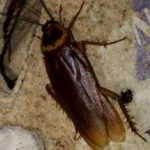
The American cockroach is one of the more frequent visitors to school floor drains in TX.
Infrequently used drains should be screened to eliminate cockroach access, or flushed weekly with a gallon or so of water to maintain water in the trap. Screens may not be practical in areas where food waste and other particles may need to be washed down the drains. In such locations baits applied to the inside of the drain may be used without interfering with drainage.
Another problem occurs when food waste and debris builds up in and around floor drains. This is often overlooked during a sanitation inspection because such buildup may occur in the cracks around the edge of the drain. A butter knife or putty knife can be an invaluable tool for probing and cleaning crevices around floor drains. In addition to grooves around the floor drain be sure to check around and under any cracked or damaged floor tiles next to the drain.
When it comes to drains, sanitation is fly control. The only way to eliminate a chronic drain fly, phorid fly or fruit fly infestation from a room is to locate and eliminate the breeding site. In kitchens, the floor drain is often the site of fly breeding.


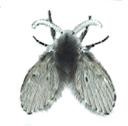 Fruit flies (left) are identified by their stocky bodies and reddish eyes. Phorid flies (middle) are humpbacked in profile and have heavy veins in the front of the wings. Moth/Drain flies (right) have broad, scaly, spear shaped wings that fold flat and form a V-shape when at rest.
Fruit flies (left) are identified by their stocky bodies and reddish eyes. Phorid flies (middle) are humpbacked in profile and have heavy veins in the front of the wings. Moth/Drain flies (right) have broad, scaly, spear shaped wings that fold flat and form a V-shape when at rest.
To test whether a particular drain is the source of a fly problem, try covering the drain with a piece of duct tape or other sticky tape. Flies will adhere to a piece of tape left overnight and reveal the source of an infestation.
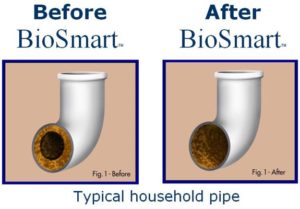
Bacterial deposits in drains are habitats for moth and drain flies. Using microbial scum digesters to clean them can reduce a population.
A bucket of bleach water is NOT an adequate treatment for a floor drain with flies. Physical scrubbing with a brush and bleach solution can work. Or you can use one of the excellent bacterial gel products to eat away slime buildup on the insides of drains. Drain flies, in particular, breed in accumulations of slime that often coat drain walls.
The presence of phorid flies coming from a drain area may indicate a more serious problem. Phorid flies often serve as an indicator of a broken sewage line. As organic-rich wastewater passes through a damaged line, some of the solution seeps into surrounding soil. This can provide the perfect breeding ground for phorid flies. If you have an ongoing phorid fly problem, consider having the sewage lines inspected for leaks and repaired as needed.
One way you can prevent these types of pests from occurring is installing one-way trap guards that allows for water to go down the drain, but closes up when not in use. This upfront expense on a new or remodeled kitchen may seem steep at first, but as time goes on it can reduce problems in an area prone to multiple pest problems.
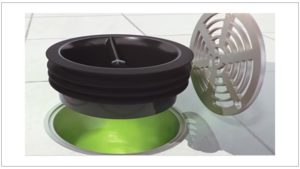
Plumbing devices that allow for water to go down, but keeps pests from coming up can be installed in a variety of locations.
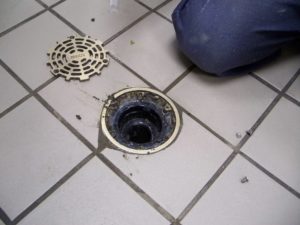
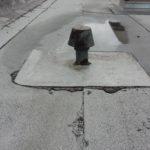 Finally one more area you might want to check is roofs. As the roof ages water can build up, this can allow for moisture to move in that can lead to mold and mildew. This problem can go undetected until the flying insects are so numerous that everyone is complaining. This is a good time to make sure that moisture is not collecting on surfaces that support mold/mildew growth.
Finally one more area you might want to check is roofs. As the roof ages water can build up, this can allow for moisture to move in that can lead to mold and mildew. This problem can go undetected until the flying insects are so numerous that everyone is complaining. This is a good time to make sure that moisture is not collecting on surfaces that support mold/mildew growth.
Written by Mike Merchant and Janet Hurley

 .
.